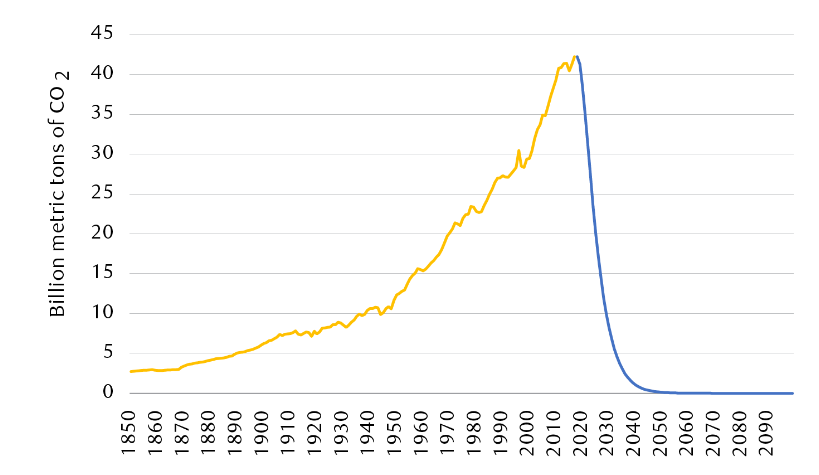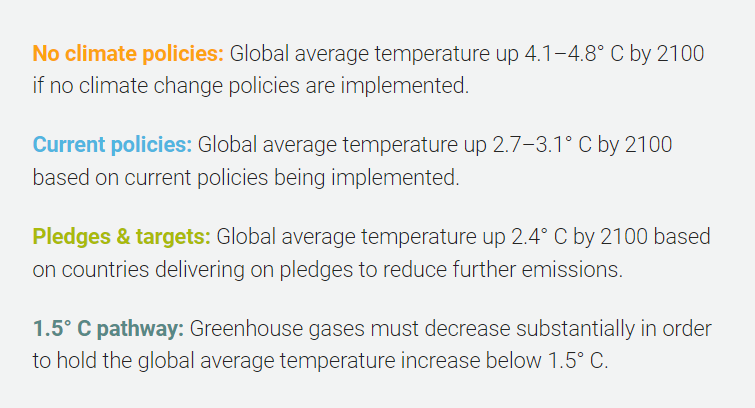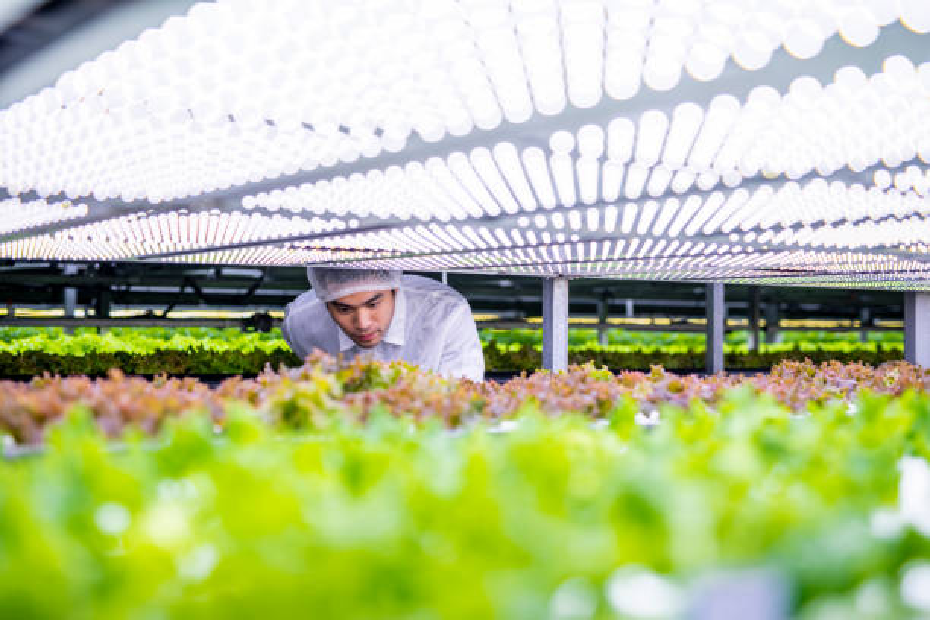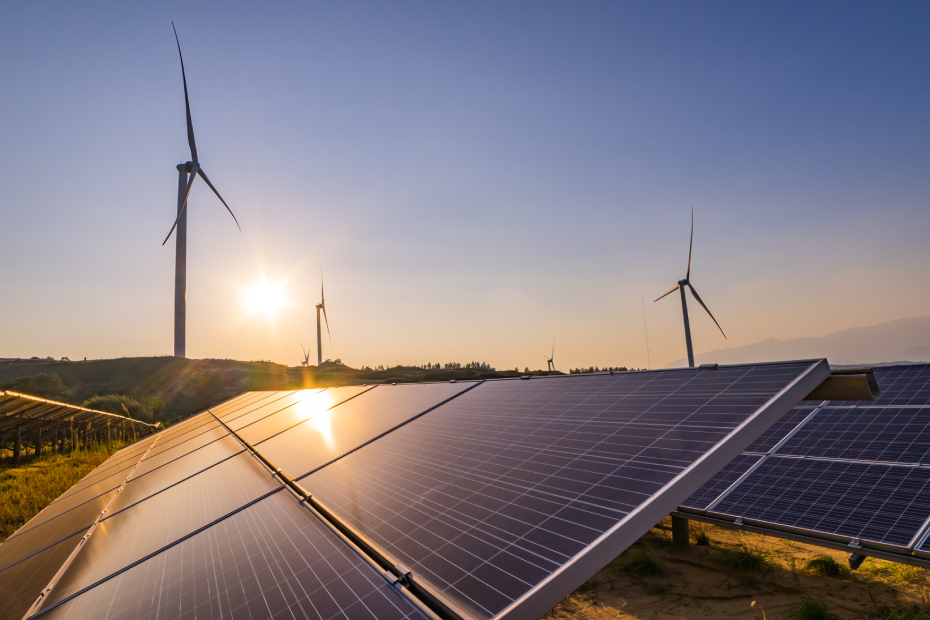This article originally appeared on Wealth Management on March 2, 2022.
Much in the way today’s hyperconnected society is worlds apart from the pre-internet days of 30 years ago, life in 2050 will probably be very different from today. On one important front — the fight against global warming — most countries will have tried to reach “net zero,” a state where the amount of greenhouse gas emissions (GHG) added to the atmosphere is balanced by that removed.
We explore some of the most eye-catching changes our children and grandchildren will likely experience in key areas of their lives. After assessing the difficulties in achieving net zero, we review some investment implications.
What does net zero really mean?
The term net zero carries within it the message that even if all efforts are made to reduce human-produced carbon dioxide and other planet-warming gases if renewables replace coal and other fossil fuels, and even if green hydrogen is scaled up massively, certain sectors for which these solutions are somewhat impractical, such as aviation or farming, will still produce carbon emissions. Emissions that can’t otherwise be avoided will need to be removed from the atmosphere via solutions such as direct air capture of CO2, or by nature-based solutions, for example, tree planting.
CO2 reductions needed to achieve net-zero emissions by 2050:
This action aims to help cap the rise in the global average temperature below 1.5 degrees Celsius

Note: CO2 reductions necessary if mitigation had started — with global emissions peaking and quickly reducing — in 2019.
Source: OurWorldinData.org
The extent of global warming is proportional to the amount of carbon dioxide added to the atmosphere. Thus, to stabilize climate change, net GHG emissions need to fall to zero, i.e., net zero.
The expression comes from an Intergovernmental Panel on Climate Change (IPCC) report in 2018 that called for capping the warming of the planet to below 1.5 degrees Celsius above the pre-industrial average temperature in an attempt to avoid the worst impacts of climate change, such as (even more) extreme weather and potentially disastrous increases in sea levels.
Achieving this will be no small feat as temperatures today are already one degree Celsius above the pre-industrial level and continue to climb, driven by 51 billion metric tons of GHGs emitted worldwide each year. To achieve the temperature goal, the IPCC estimated that global carbon dioxide emissions must fall by about 45 per cent by 2030 and to net zero by 2050.
Many countries and regional blocs, including the U.S., UK, and the European Union (EU), have committed to reaching net zero by 2050; China targets 2060. Some nations have made the commitment legally binding. Meanwhile, many businesses have declared their intentions to meet this goal by mid-century.
The future increase in the global average temperature will depend on reducing GHG emissions.
Global GHG emissions and warming scenarios


Note: 1 gigatonne = 1 billion metric tons. Annual emissions less than zero reflect the removal of greenhouse gases from the atmosphere. Based on national policies and pledges as of May 2021, prior to new pledges made at the UN summit on climate change, COP26, in November 2021. GHG emissions include carbon dioxide, methane, and nitrous oxide.
Source: Climate Action Tracker (Licensed under CC-BY by Hannah Ritchie & Max Roser), OurWorldinData.org, RBC Wealth Management
A net-zero world by mid-century
Our descendants will live in a world that will be a very different place to how it is today, with wholesale changes in their homes, modes of transport, and the landscape that surrounds them.
Decarbonized homes
Homes will likely receive 95 per cent of their electricity from wind and solar versus some 40 per cent in 2020. Most fossil-fuel-powered furnaces and boilers will very likely be replaced by heat pumps.
Heat pumps are devices powered by electricity that extract heat from the air or ground to warm a fluid that is compressed to boost the temperature. In effect, they operate like a refrigerator in reverse.
Though the technology has been in use for some time, there are impediments to scaling it up. Heat pumps are refrigerator-sized, while installation can be costly and disruptive. Still, nearly 20 million households purchased heat pumps in 2019, according to the International Energy Agency (IEA), meeting five per cent of global home heating demand. The IEA estimates this share needs to triple by 2030 to meet net-zero goals.
Innovation is needed to reduce the size of the units while offering a cooling option as well as heating.
Policy support will also be needed to speed up the adoption of this new technology. In the UK, from 2025, gas-fired boilers will be banned in newly built homes, while the installation of new replacement gas boilers in existing houses will be prohibited by the mid-2030s. To encourage the use of heat pumps, the UK government is offering a number of grants to households.
Homebuilding may also see big changes. Either the key raw materials used today, steel and cement, will be processed differently, or substitutes will have to emerge.
The steel and cement industries are massive CO2 emitters, each accounting for roughly seven per cent of total global emissions, according to the IEA. “Greening” these heavy industries will be important to achieve net zero.
Several emerging technologies, which are close derivatives of well-understood and commercial processes used today, could yield significant emissions reductions in the medium term. In the steel industry, pilot programs are using hydrogen to complement or replace coal in the high-temperature combustion process. Meanwhile, feasibility studies suggest the use of hydrogen could substantially reduce the amount of carbon that is emitted from a cement kiln. At the same time, it appears mixing carbon dioxide with the water used to cure concrete can add usefully to its strength, meaning less cement can be used while simultaneously locking away the carbon in the concrete.
Engineered timber frames for buildings are another innovation that will increasingly be used to replace steel and cement. Cross-laminated timber (CLT) is produced by gluing planks of wood together, layering the grain of the wood at right angles. CLT was first used in a high-rise building in Vancouver in 2017, and other skyscrapers have made use of it since.
Window panes could even be made of wood. Swedish scientists found ways to extract pigments from wood, resulting in a transparent material that can be used much like glass but weighing less and insulating more.
Finally, roofs will increasingly be covered by solar panels or vegetation to provide a natural form of insulation and reduce energy consumption.
Transformed transport
It’s widely expected that electric vehicles (EVs) will be ubiquitous, but their capabilities will likely be far more efficient than today’s models.
For one, an EV that is not in use may feed energy back to the grid via two-way charging points. In this way, EVs can act as an aggregated megabattery, helping the grid offset the inevitable vagaries of wind and solar power. After all, cars are idle most of the time, and a large amount of battery power is unutilized.
It’s also likely that wireless charging technology will dramatically evolve, both with respect to home wireless chargers as well as the possibility of charging an EV battery even as the vehicle is being driven.
While electric trains have been around for decades, diesel engines remain the most pervasive power source and are ripe for replacement. South Korea already operates electric multiple unit trains, and it intends to phase out all of its diesel passenger trains by 2029. French manufacturer Alstom is running a hydrogen-powered passenger train service in Europe, which it expects to roll out more widely over the next several years. Meanwhile, Canadian Pacific Railway has put eight hydrogen-powered freight locomotives into service to assess their viability.
In aviation, electric airplanes are not yet practical due to the huge onboard weight of batteries. Late in 2020, Airbus announced that hydrogen-fueled propulsion systems would be central to a new generation of zero-emissions commercial aircraft. The project is a flagship of the EU’s COVID-19 stimulus package that aims to green the bloc’s economy. Airbus believes its planes could be ready by 2035, though whether their use becomes commonplace will depend on hydrogen being produced at scale and without a large carbon footprint, challenges in their own right.
Reshaped landscape
The landscape of 2050 will be different beyond simply the further proliferation of wind turbines and solar panels, which have already become prevalent over the years. In cities, more green spaces to lock up CO2 will be widespread.
With homes receiving the majority of their electricity from wind and solar and a greater amount of electricity generation directed at transport, more transmission infrastructure, including pylons and substations, will be needed to carry energy to homes and factories.
Travellers may see tram-style overhead power cables hovering above a truck lane on the highway—the electric motorway. Trucks emit between 15 per cent and 18 per cent of CO2 emissions and German conglomerate Siemens has been at the forefront of an innovative technology to reduce this.
Siemens’ first “eHighway” was piloted in Sweden, with diesel hybrid vehicles manufactured by Scania adapted to operate with power from an overhead contact line. A similar system was also tested in Los Angeles. The UK government commissioned a study in 2021 to assess the economic and technical potential of a national rollout of this technology, which offers many advantages beyond cutting emissions and improving air quality. It can eliminate the dependency on battery range performance while increasing utilization rates as it would eliminate idle time during charging.
In addition, given that a massive reduction in the amount of carbon dioxide already in the atmosphere will be necessary, direct air capture (DAC) facilities, which extract CO2 directly from the air, are likely to be built on the edge of urban areas. These will look like rows of boxes containing fans humming away.
The IPCC suggests that to keep global warming below 1.5 degrees Celsius, around 730 billion metric tons of CO2 must be taken out of the atmosphere by the end of this century in addition to a significant reduction in emissions. That is equivalent to all the CO2 emitted by the U.S., the UK, and China since 1750.
DAC removes CO2 from the atmosphere by forcing air over a chemical that grabs CO2, then compresses, transfers, and stores it in deep geological formations. Currently, 19 DAC plants are in operation worldwide, capturing 10,000 metric tons of CO2 per year.
The problem is cost. The largest DAC facility operating today in Iceland and operated by ClimeWorks, a Swiss firm, can remove 4,000 metric tons of CO2 from the air per year and store it in mineral form at a cost of $600 to $800 per metric ton. Scaling up the technology can bring the price down. Canada’s Carbon Engineering believes it’s much larger plant with a planned capacity of one million metric tons per year, scheduled to open in three years’ time in Texas, can operate at a much lower cost, in a range of $90 to $240 per metric ton.
According to Carbon Engineering, DAC technology combined with secure geological storage can deliver permanent and verifiable removal of carbon dioxide from the air, reversing the emissions process, and provide sectors struggling to decarbonize, such as aviation, shipping, and oil and gas, with a potential path to achieve net-zero targets.
To reach net zero by 2050, DAC will need to be scaled up to capture more than 85 million metric tons of CO2 per year by 2030 and approximately 980 million metric tons per year by 2050, according to the IEA. To put the level of infrastructure in place to realize these goals will require targeted government support, including grants and public procurement.
A cheaper option to remove CO2 is planting trees, and reforestation efforts have increased in recent years. The IPCC suggests that increasing the total area of the world’s forests, woodlands, and woody savannahs could store around one-quarter of the atmospheric carbon necessary to limit the rise in the global average temperature below 1.5 degrees Celsius—though this would require adding up to 24 million hectares of forest (roughly the size of the U.S. state of Oregon) every year from now until 2030.
Recent national reforestation efforts are nowhere near that level, despite several countries having announced ambitious plans. But people in 2050 are nevertheless likely to see more woodland areas. Encouragingly, the shift toward plant-based diets may free up to 20 per cent of farmland for other uses, according to the UK’s Climate Change Committee, a statutory body.
Planting trees may be cost-effective, but it may not be the most efficient method to pull CO2 from the air, given how large reforestation areas have to be in order to make a difference. Moreover, trees can burn in wildfires or be cut down, causing much of the stored carbon to be released. Simply, reforestation cannot reduce emissions on its own.
Some industries set to benefit from the energy transition
A wide range of industries are working toward achieving the greening of the economy
| Transformation | Industry |
| Renewables |
|
| Energy storage |
|
| Transmission/distribution |
|
| Electric vehicles |
|
| Hydrogen |
|
| Heat pumps/eHighways |
|
| Engineered timber frames |
|
Source: RBC Wealth Management
Can net zero ever be achieved?
Achieving net zero is a huge task with enormous challenges, as we described in a recent article on the green energy transformation.
One of these is the hefty price tag. A 2019 World Bank estimate suggested the necessary global infrastructure investment would cost $90 trillion. Spread over 30 years, this would amount to about 0.2 per cent to 0.3 per cent of GDP per annum, which is manageable, in our view. Moreover, the same study also estimated that the investment could be recouped four times over.
Certainly, the cost of inaction could be higher than the investment needed. Reinsurer Swiss Re recently estimated that the global economy could be seven per cent to 10 per cent smaller in 2050 than now as a result of the cost of climate change (including the damage from extreme weather), as well as parts of the planet becoming uninhabitable, fueling hunger and migration.
Though the solutions for countries to achieve net zero do exist or are in early development, many need to be scaled up, a process that is capital intensive and fraught with difficulties. It is an encouraging sign that at the recent UN climate summit, COP26, not only did nations pledge to meet net-zero targets by 2050 but so did more than 5,000 businesses.
That said, just as the uptake of both solar and wind energy over the past two decades was encouraged by policy support, such as tax credits, subsidies, and government-backed loans, the same approach and resolve will be needed to help these technologies become commercialized.
Pragmatism should prevail
For investors, this represents both risks and opportunities. Our view is that investors should maintain a pragmatic approach given the serious gaps between net-zero ambitions and potential outcomes. High-emissions companies that do not adapt are likely to incur difficulties. Those that adapt or develop new technologies, if given support to reach commercialization, will likely find themselves in a position to benefit from this transformation.
This article was originally published on rbcwm.com
This article is intended as general information only and is not to be relied upon as constituting legal, financial or other professional advice. A professional advisor should be consulted regarding your specific situation. The information presented is believed to be factual and up-to-date but we do not guarantee its accuracy and it should not be regarded as a complete analysis of the subjects discussed. All expressions of opinion reflect the judgment of the authors as of the date of publication and are subject to change. No endorsement of any third parties or their advice, opinions, information, products or services is expressly given or implied by Royal Bank of Canada or any of its affiliates.
This article is intended as general information only and is not to be relied upon as constituting legal, financial or other professional advice. A professional advisor should be consulted regarding your specific situation. Information presented is believed to be factual and up-to-date but we do not guarantee its accuracy and it should not be regarded as a complete analysis of the subjects discussed. All expressions of opinion reflect the judgment of the authors as of the date of publication and are subject to change. No endorsement of any third parties or their advice, opinions, information, products or services is expressly given or implied by Royal Bank of Canada or any of its affiliates.



















